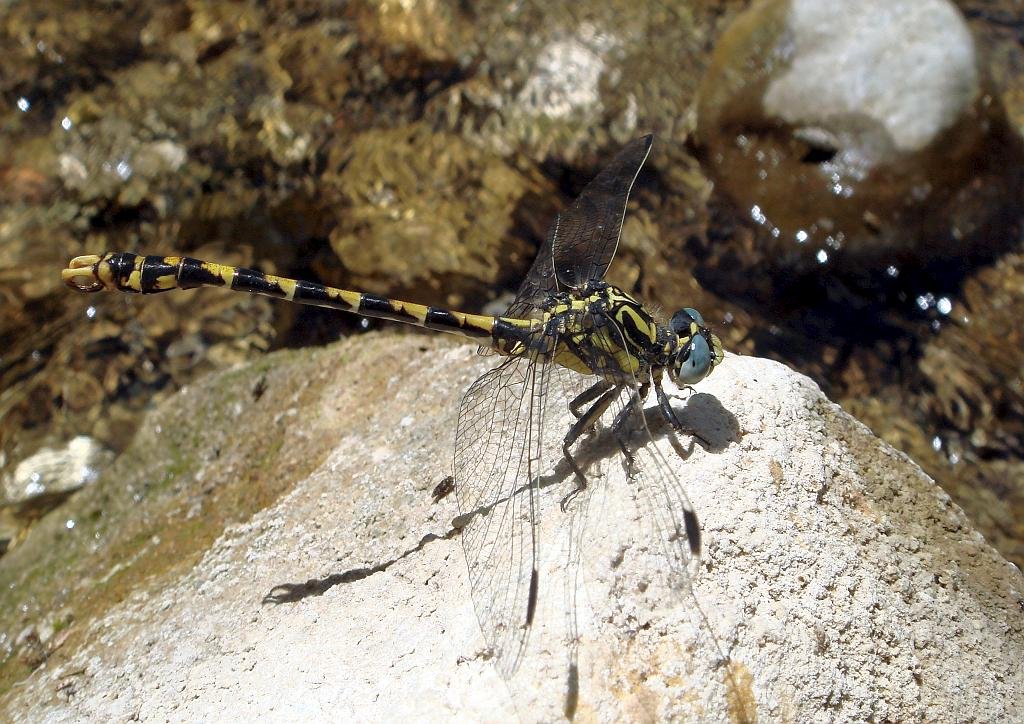- English common name: Small Pincertail
- Scientific name: Onychogomphus forcipatus (Linnaeus, 1758)
- Family: Gomphidae
- Total length: 46 to 50mm
- Hind Wing length: 25 to 31mm
- Flight period in Iberia: May to mid September
- Distribution: Europe (except Britain), North Africa & the Near East. Widely distributed throughout the Iberian Peninsula, though apparently absent from the coastal fringes of Galicia, Asturias, Cantabria.
- Habitat: Usually rivers & streams with regularly protruding rocks or boulders, occasionally larger still water bodies.
- Similar species: Very similar to the Large Pincertail (Onychogomphus uncatus) which contrary to its name is only marginally bigger than the Small Pincertail.
The Small Pincertail (Onychogomphus forcipatus) is a relatively common & widespread species in the Iberian Peninsula, though apparently absent from the west coast regions of Portugal & the north coast regions of Spain.

This dragonfly frequently occurs along rivers & streams, often with very shallow water, peppered with large boulders & rocks from where mature males sit with their claspers raised defending small transient territories perhaps 2.5 to 3 metres apart. Although preferring moving water, occasionally they are also present at lakes.
There are three subspecies of Onychogomphus forcipatus with Onychogomphus forcipatus unguiculatus being the one that occurs throughout the Iberian Peninsula. It is a predominantly black & yellow, medium size dragonfly, with blue eyes in the Mediterranean area, (though greenish eyes further north in Europe).
It is very similar in appearance to the Large Pincertail (Onychogomphus uncatus) and the two species cannot be reliably separated by colour markings alone. For instance the black stripes on the upper surface of the thorax are usually connected via the black central keel in the Small Pincertail, whereas the Large Pincertail there is a gap between the two, sadly however that is not always the case!
The anal triangle on the hind wings of a male also offers a method of separating the two species, usually comprising of 3 cells in the Small Pincertail (see photo) and 4 cells in the Large Pincertail.
However, the male anal appendages offer a more reliable feature to separate the two species with the Small Pincertail having a subterminal knob on the inferior anal appendage (see photo). This feature can only really be seen clearly by examining the insect in the hand, or perhaps a little more easily, by taking a digital photo, concentrating on a side view of the anal appendage and enlarging it on a screen.


Iberia Nature Forum
Discover the Iberia Nature Forum – Environment, geography, nature, landscape, climate, culture, history, rural tourism and travel.
Iberia Nature Forum: https://iberianatureforum.com/
I’ve been living in this lovely area of Western Andalucia for the last 20 years or so and dedicate most of my time to the running of English language tourist information websites for the towns of Cádiz, Ronda, Grazalema, the famous or infamous Caminito del Rey, and also Wildside Holidays, which promotes sustainable and eco-friendly businesses running wildlife and walking holidays in Spain. My articles contain affiliate links that will help you reserve a hotel, bus, train or activity in the area. You don’t pay more, but by using them you do support this website. Thankyou!
